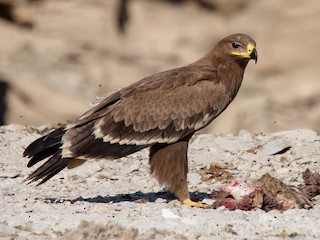
Steppe Eagle
Aquila nipalensis
Order:
Family:
Size:
60-81 cm
Weight:
M 2000-3500 g, F 2300-4900
Taxonomy:
A. n. nipalensis (Hodgson, 1833)
Short Description:
he steppe eagle (Aquila nipalensis) is a bird of prey. Like all eagles, it belongs to the family Accipitridae. It was once considered to be closely related to the non-migratory tawny eagle (Aquila rapax) and the two forms have previously been treated as conspecific. They were split based on pronounced differences in morphology and anatomy; two molecular studies, each based on a very small number of genes, indicate that the species are distinct but disagree over how closely related they are. It is about 62–81 cm (24–32 in) in length and has a wingspan of 1.65–2.15 m (5.4–7.1 ft). Females, weighing 2.3–4.9 kg (5.1–10.8 lb), are slightly larger than males, at 2–3.5 kg (4.4–7.7 lb). This is a large eagle with brown upperparts and blackish flight feathers and tail. This species is larger and darker than the tawny eagle, and it has a pale throat which is lacking in that species. Immature birds are less contrasted than adults, but both show a range of variation in plumage colour. The eastern subspecies A. n. nipalensis is larger and darker than the European and Central Asian A. n. orientalis. The call of the steppe eagle sounds like a crow barking, but it is rather a silent bird. The steppe eagle breeds from Romania east through the south Russian and Central Asian steppes to Mongolia. The European and Central Asian birds winter in Africa, and the eastern birds in India. It lays 1–3 eggs in a stick nest in a tree. Throughout its range it favours open dry habitats, such as desert, semi-desert, steppes, or savannah. Egg, Collection Museum WiesbadenIt is found in south-eastern Pakistan especially in Karachi. Large numbers are seen at certain places such as Khare in Nepal during migration. As many as 15.3 birds per hour during October and November have been noted.[7] The steppe eagle's diet is largely fresh carrion of all kinds, but it will kill rodents and other small mammals up to the size of a hare, and birds up to the size of partridges. It will also steal food from other raptors. Like other species, the steppe eagle has a crop in its throat allowing it to store food for several hours before being moved to the stomach. In Pakistan, Steppe Eagle is considered as a winter migrant, but breeding records in Salt Range and Khushab. A Common Raptor which favours vicinty of large lakes and wetlands. A communal roost of 30-40 can be seen on escarpment of south Islamabad. The population has increased recently, mainly due to their scavanging behavior.
Far far away, behind the word mountains, far from the countries Vokalia and Consonantia, there live the blind texts. Separated they live in Bookmarksgrove right at the coast
Lahore,Bahawalpur,Rahim Yar Khan,Kasur,Vehari,Bahawalnagar,Multan,Bhakkar,Chakwal,Chiniot,Dera Ghazi Khan,Jhang,Jhelum,Khanewal,Khushab,Layyah,Lodhran,Mandi Bahauddin,Mianwali,Narowal,Nankana Sahib,Okara,Rawalpindi,Sialkot,Toba Tek Singh,Badin,Jacobabad
Steppe Eagle (Aquila nipalensis) exhibits distinct behavior reflective of its predatory nature and migratory habits. These majestic birds of prey primarily hunt small mammals, birds, and reptiles, often scanning the ground from elevated perches or soaring high in the sky. Steppe Eagles are known for their impressive aerial displays, utilizing thermal currents to effortlessly glide while searching for prey. During the breeding season, they establish nesting territories in open landscapes, constructing large stick nests in trees or on cliffs. Both parents participate in incubating the eggs and caring for the young. As migratory birds, Steppe Eagles undertake long-distance journeys between their breeding grounds in Central Asia and their wintering areas in South Asia, including Pakistan. Their migration routes often span vast distances, crossing multiple countries and ecosystems.
Far far away, behind the word mountains, far from the countries Vokalia and Consonantia, there live the blind texts. Separated they live in Bookmarksgrove right at the coast
About Photographer : Hello World
Facebook
Twitter
Instagram
Flicker
LinkedIn

